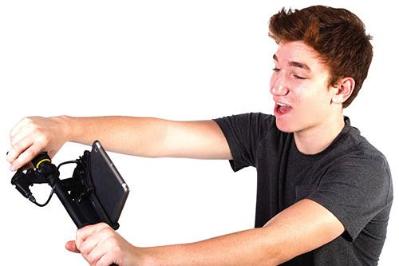 The idea behind both of these accessories is that they take over interacting with your phone’s screen for you, giving you a secure place to put your phone while you’re gaming. In both cases a mechanism is used to tap the screen in a specific location; usually that location is close to where your thumb (if you’re like most people) would rest.
The idea behind both of these accessories is that they take over interacting with your phone’s screen for you, giving you a secure place to put your phone while you’re gaming. In both cases a mechanism is used to tap the screen in a specific location; usually that location is close to where your thumb (if you’re like most people) would rest.
In addition to this screen tapper, they include an expandable bracket to hold your phone; it grips it like a claw at three points and has padded edges so it won’t do any damage to the device.
The BowBlade is shaped like a bow, while the GameBarz is shaped like a pair of bicycle handlebars. Let’s take a look at the BowBlade first.
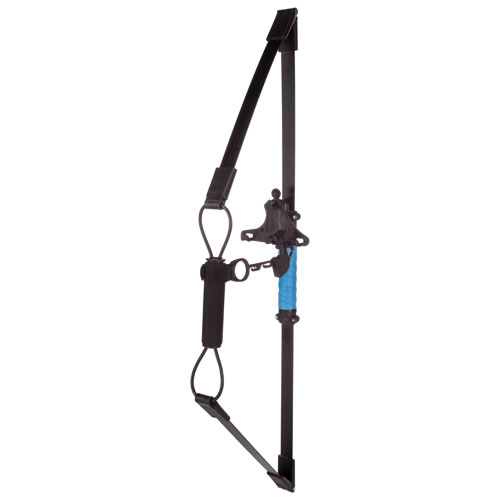 BowBlade Overview
BowBlade Overview
BowBlade is about 24” long. It’s a curved piece of plastic that resembles a short bow, with a piece of stretchy cord going from the top to the bottom. Halfway along the cord is a finger loop. This is the crux of how BowBlade works: pick it up like a bow, with your phone in the cradle (under the tapping mechanism) and your app booted. You can aim your new bow like it’s a real one, and by pulling back on the string and putting tension on it, you’re able to slide your finger through the loop. To activate the firing mechanism, you simply pull the loop like a trigger.
GameBarz
GameBarz is similar to BowBlade in that there is a cradle for your phone with a tapping mechanism. It’s attached to a flat bar that looks like the handlebars of a bicycle. The trigger here isn’t a loop, it’s a brake lever like on a bike.

You can hold the GameBarz horizontally, with both hands. You can also hold it vertically with one hand.
Are they fun to use?
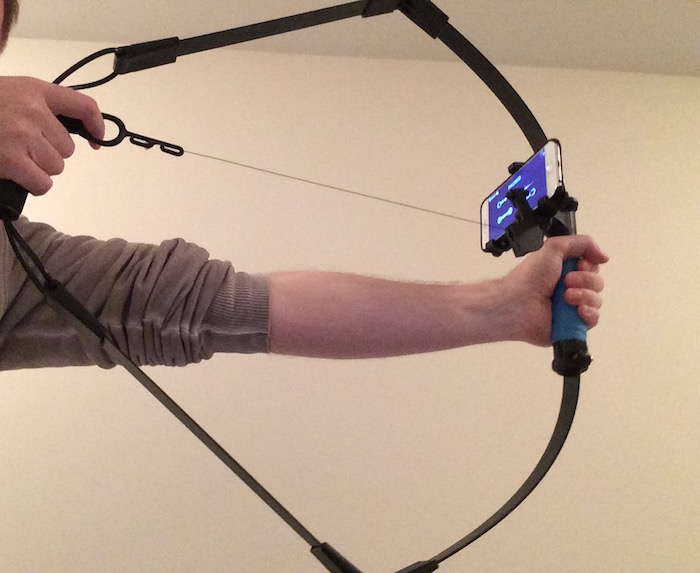 I tested out a variety of titles that are compatible with both BowBlade and GameBarz; generally these games are first person perspective, use motion controls for aiming or direction, and have a gameplay element that involves tapping a corner of the screen and / or shaking the whole device.
I tested out a variety of titles that are compatible with both BowBlade and GameBarz; generally these games are first person perspective, use motion controls for aiming or direction, and have a gameplay element that involves tapping a corner of the screen and / or shaking the whole device.
From a functional standpoint both devices work extremely well. They grip the phone nicely, and the action on the tapper is clean and responsive. Pulling the trigger on the BowBlade has decent travel–that is to say that it moves quickly and accurately. I had a few people try it out to see if varying finger sizes made a difference; the report back was that the experience was similar for both adults and children with hands of all sizes.
In GameBarz case, it’s an interesting addition. There are some cool things you can do with a device that grips your phone tightly while also giving you two handles to keep the whole lot safely in your hands. You can flick the phone, like you’re popping a wheelie, and the device holds the phone fast without a lot of worry of it coming lose. Maybe I’m paranoid, but I still didn’t feel comfortable about getting too wild with it.
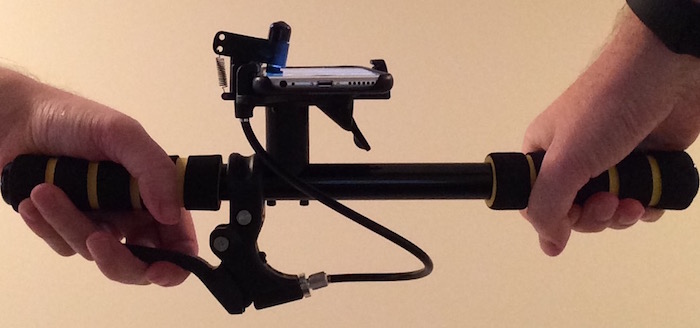
One interesting aspect is that you can turn the whole apparatus sideways, holding it like a fishing rod. You can cast with the brake lever, and use a flicking motion to get the sense that you’re actually fishing. This is a type of gameplay that I haven’t personally engaged in since way back in the Sega Dreamcast days; that unit had a winder as well, making it a more legit experience, but it’s still pretty cool to see this type of play return.
So getting down to the brass tacks of the question of “is it fun?” yields two answers.
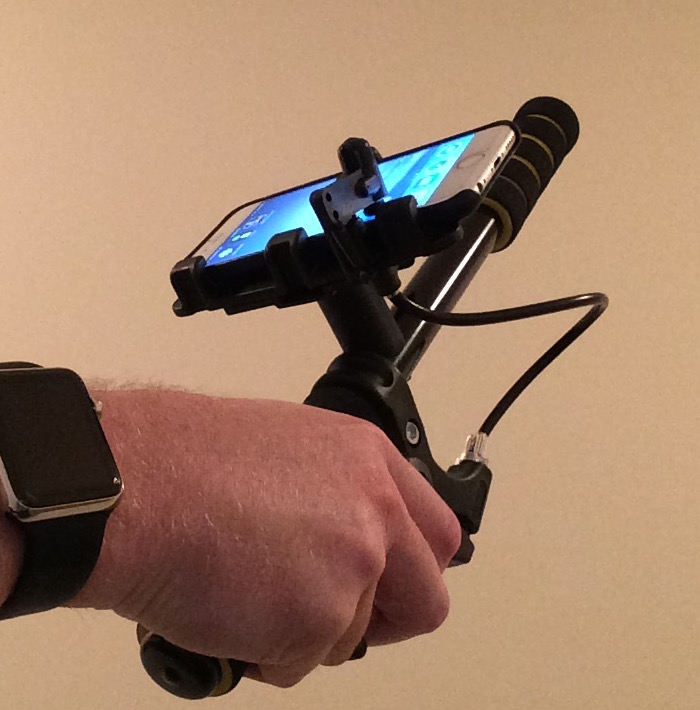 I really like GameBarz and think it’s cool. The apps and games seem to make more sense, the unit is lighter and smaller, and easier to store and transport. The brake lever attachment is a much more natural fit for me, and it opens up a few different types of game. Having a solid two-handed grip on the unit means you’re less likely to be concerned about your phone and more likely to be engaged in the game.
I really like GameBarz and think it’s cool. The apps and games seem to make more sense, the unit is lighter and smaller, and easier to store and transport. The brake lever attachment is a much more natural fit for me, and it opens up a few different types of game. Having a solid two-handed grip on the unit means you’re less likely to be concerned about your phone and more likely to be engaged in the game.
That brings us to BowBlade. If you’re into archery, I can see how this would be a fun toy for you. If you really like Stephen Amell (and who doesn’t??) or you’re an Arrow fan who aspires to punish those who have “failed this city” you might be find this to be a cool addition.
While I’m a big fan of Amell and Arrow, and I spent a few years at the archery range at Pleasant Bay Camp in Ontario, I really didn’t have a lot of fun with BowBlade per se. It felt like an interesting idea that I’m not sure I really connected with; you pull the bowstring back and… pull a trigger?
There are more than a few bows out there that can (and in some case need to) be used with a trigger mechanism, but here it feels a bit tacked on. With trigger mechanisms for traditional bows there is a release of tension that accompanies the shot; that doesn’t happen with BowBlade. You draw the string, pull the trigger, and you still have the string drawn. It’s a weird feeling and pulled me out of the action over and over.
I should mention that my arms got tired as I played; that seems to be the point though: build up your strength to overcome that fatigue. I’m a pretty frequent gym-goer and I do lift fairly heavy and still the repetitive motion of BowBlade did give me a workout–so if you’re looking for some strength-building, this is a good choice. It’s probably a good idea to switch arms regularly; both arms get a work out either way, but it does feel a bit more directed towards the arm doing the pulling.
Conclusions
Who’s this for? Well, it seems like if you have a love of hunting and fishing, both of these devices will scratch that itch. I feel like the same group that loved Cabela’s Big Game Hunting might go for this. GameBarz is easier to pack away when you’re not playing with it; BowBlade is pretty darned big.
As for software: for both systems I stuck with the popular, free iOS games on BowBlade.net to test. There are over 75 games available (both free and paid) for both devices, giving you lots to work with.
If you need to work on arm strength or the other for physical therapy, I can see how BowBlade might be advantageous.
For everyone else: check out GameBarz, and give it a go. It makes a great gift for the gamer in your life, if they like mobile gaming peripherals.



